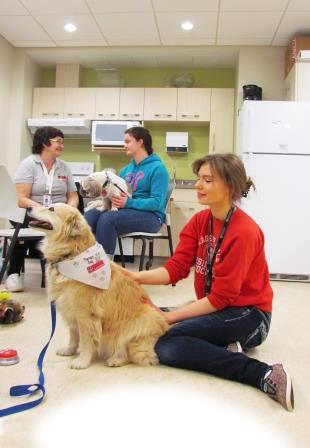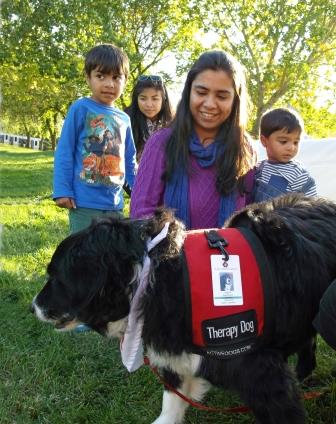The Medical Benefits of St. John Ambulance Therapy Dogs
Reducing stress, decreasing pain and bringing a smile to the faces of those in need - these are just a few of the benefits that pet therapy can bring. The St. John Ambulance Therapy Dog program involves visits by teams of dog-owning community volunteers to facilities throughout Saskatchewan, including retirement homes, schools, hospitals and universities. The Therapy Dog teams are evaluated by St. John Ambulance evaluators to a national standard and are placed into facilities where they will thrive. The evaluation tests the temperament and behavior of the dog through different scenarios that may occur during a Therapy Dog visit. St. John Ambulance currently has over 100 Therapy Dog teams visiting facilities throughout the province.
PHYSIOLOGICAL EFFECTS OF THERAPY DOGS
 Animal-facilitated therapy on patients in medical settings has been shown to reduce heart rates, respiration rates, pupillary constriction and increase peripheral skin temperature. Each of these changes is indicative of relaxation. Brief Therapy Dog visits result in reductions in stress hormones, such as epinephrine and norepinephrine, as well as increases in endorphin levels. Oxytocin levels have also been shown to increase after dog interactions; oxytocin offers anti-stress effects and increases the pain threshold. Patients have reported significant pain reduction (both chronic and acute)
Animal-facilitated therapy on patients in medical settings has been shown to reduce heart rates, respiration rates, pupillary constriction and increase peripheral skin temperature. Each of these changes is indicative of relaxation. Brief Therapy Dog visits result in reductions in stress hormones, such as epinephrine and norepinephrine, as well as increases in endorphin levels. Oxytocin levels have also been shown to increase after dog interactions; oxytocin offers anti-stress effects and increases the pain threshold. Patients have reported significant pain reduction (both chronic and acute)
after visits with a Therapy Dog. In addition to pain relief, patients reported a decrease in stress, mood disturbances and fatigue associated with the Therapy Dog visits. Blood tests observing hormone levels showed the same results with positive changes in endorphin, prolactin, phenyl acetic acid and dopamine levels. Serum cortisol levels were also decreased, supporting that the human-animal interaction relieves stress.
A majority of research in the area of animal-assisted therapy (AAT) looks only at the response patients have when the animal is present. Research has determined that therapeutic use of an animal provides a needed distraction for hospitalized individuals and makes an unfamiliar setting more homelike.
CHILDREN AND THERAPY DOGS
 Children also benefit from animal-assisted therapy. Being hospitalized as a child can be very stressful as they are experiencing major developmental changes. Normal developmental growth incorporates play time and enables a child to master anxiety, externalize problems and conflicts, rehearse new solutions and turn from passive to active roles in conflict resolution. During play, they are able to exert control over a situation by creating choices within play. If a child is immunocompromised, hospitalized, or too weak to play, this crucial play time may be reduced. Dog therapy helps children to reduce stress and engage in play time providing them a method of coping.
Children also benefit from animal-assisted therapy. Being hospitalized as a child can be very stressful as they are experiencing major developmental changes. Normal developmental growth incorporates play time and enables a child to master anxiety, externalize problems and conflicts, rehearse new solutions and turn from passive to active roles in conflict resolution. During play, they are able to exert control over a situation by creating choices within play. If a child is immunocompromised, hospitalized, or too weak to play, this crucial play time may be reduced. Dog therapy helps children to reduce stress and engage in play time providing them a method of coping.
With the rise of children being diagnosed with autism, more research has been done with this population. Autism is a common condition in a group of developmental disorders known as Autism Spectrum Disorder (ASD). It is characterized by impaired social interaction, problems with verbal and nonverbal communication, and unusual, repetitive, or severely limited activities and interests. While interacting with a Therapy Dog, children with autism were noted to be more playful and more aware of their social environment.
Therapy Dogs have also been used with children’s reading programs where children sit with a dog and read to them. It promotes a supportive environment for the child because they can work through difficult passages without fear of being ridiculed or judged. The dog provides a social and emotional support system which raises the child’s self esteem and makes it easier to express themselves. This is demonstrated through reports from teachers indicating improved oral presentation skills amongst students participating in the program.
POWER OF PUPPY LOVE
In stressful situations, in classrooms and in hospital care, St. John Ambulance Therapy Dog teams have been proving their worth both through the anecdotal evidence and through scientific observation. Educators and health professionals can add Therapy Dog teams to their tool box when developing plans for their clients. For more information, visit the St. John Ambulance website at www.sja.ca or email cs.coordinator@sk.sja.ca.
Author: Kristyn Friesen completed her 4th year nursing practicum with St. John Ambulance working specifically with the Therapy Dog program in the summer of 2013. During the summer, she completed a research project on the medical benefits of St. John Ambulance Therapy Dogs.
This article was previously featured in the September 2014 issue of DIRECTION Magazine.



